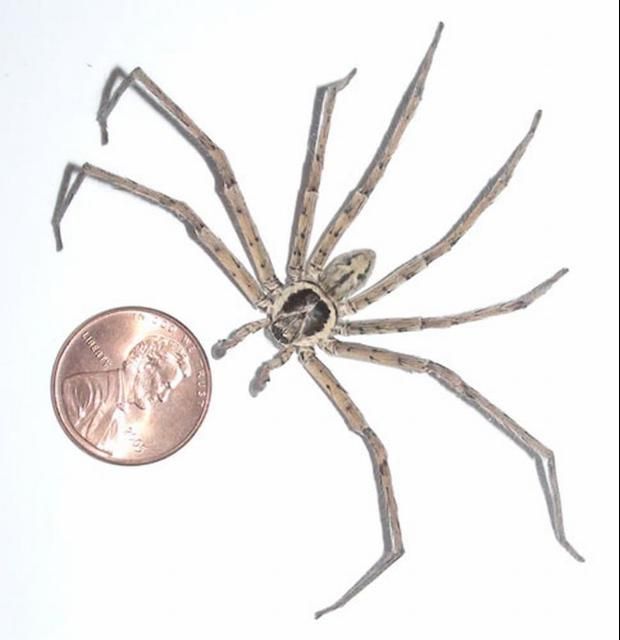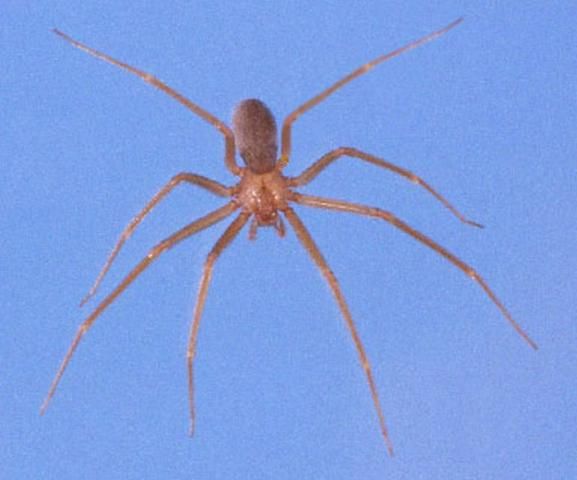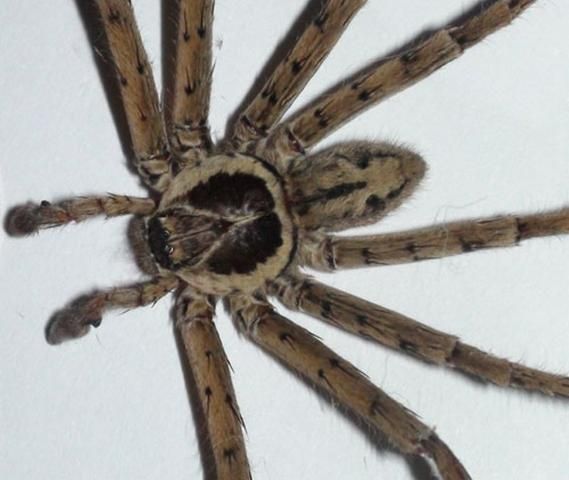The Featured Creatures collection provides in-depth profiles of insects, nematodes, arachnids and other organisms relevant to Florida. These profiles are intended for the use of interested laypersons with some knowledge of biology as well as academic audiences.
Introduction
The pantropical huntsman spider, Heteropoda venatoria (L.), sometimes called the giant crab spider or the banana spider (due to its occasional appearance in marketed bananas), is a cosmotropical species introduced into and now occurring in the United States, in subtropical areas of Florida, Texas, and California, and in coastal areas of Georgia and South Carolina. It is presumed to have been introduced from Asia, where many of its closest relatives live (Gertsch 1948). It is sometimes mistaken for a large brown recluse, Loxosceles reclusa Gertsch and Mulaik, a poisonous venomous spider in the family Sicariidae, but it is neither related nor is it dangerous. Some authors placed this spider in the family Heteropodidae, due to the uncertainty of the name Sparassidae (Platnick and Levi 1973), but the family name Sparassidae was stabilized gy Jãger (1999).

Credit: Marie Knight

Credit: Jeffrey Lotz, DPI
Abbreviated Synonymy
Aranea venatoria Linnaeus (1767)
Aranea regia Fabricius (1793)
Heteropoda venatoria, Latreille (1804)
Thomisus leucosia Walckenaer (1805)
Micrommata setulosa Perty (1833)
Description
Heteropoda venatoria is a large brown spider with a flattened body structure and very little dorsal pattern. Adult specimens have a body length of 2.2 to 2.8 cm (about 1 inch, and have a leg span of 7 to 12 cm (3 to 5 inches). Adult females have a larger body size, especially the abdomen, than males. Adult males have longer legs than females, and the long male palpi have the terminal segment enlarged and the ventral sclerites exposed, as in most true spiders. Both sexes have a yellow to cream clypeus and a wide marginal band encircling the rest of the carapace, tan in females and cream in males. In addition, males have a dark, longitudinal stripe on the abdomen and a light-bordered pale area behind the eyes. The legs of both sexes have distinct black spots from each of which arises an erectile macroseta. Otherwise, the spider is not conspicuously hairy.

Credit: Marie Knight

Credit: Marie Knight
Habits and Habitat
Females of Heteropoda venatoria make flattened, disc-like eggsacs about 1.5 cm (about 3/4 inch) in diameter which contain over 200 eggs. The eggsac is carried under the body, its size and shape probably causing the female to remain relatively immotile. All stages of development of juveniles and adults appear to occur simultaneously throughout the year.
This and similar species are highly valued in tropical countries because they capture and feed on cockroaches and other domestic insect pests. As with other vagrant spiders, huntsman spiders do not use webs to capture prey. Their great speed and strong chelicerae (jaws) are used to capture the insects on which they feed. Venom is also injected into the prey from glands extending from the chelicerae into the cephalothorax.
The flattened body enables this large spider to fit into surprisingly small cracks and crevices. This ability, along with its adaptability to human habitations, helps explain its frequent occurrence in houses, barns, sheds, under boards on the ground, and in other sheltered areas. Being cold-sensitive, these spiders cannot exist outdoors in areas with freezing winter temperatures; occasionally they occur in greenhouses and other heated buildings in temperate climates. On the other hand, in southern Florida where frost is rare, these spiders have become "wild" (i.e., no longer requiring man-made structures). In the Homestead area, Heteropoda venatoria is now established in the "wild" and is common in avocado groves (Whitcomb unpublished). They can be easily collected at night by using a headlight (Wallace 1937) as their eyes reflect light, appearing as blue spots on the trunks of trees and on the ground, much like wolf spiders.
Survey and Detection
In Florida, Heteropoda venatoria may be distinguished from other large, cursorial spiders by its flattened brown body and the black spots around the macrosetae on the legs. In warm weather, it may be found in and about human habitations; in cold weather it will be found indoors, under furniture or cabinets, behind wall hangings, and in closets and garages. It is not a dangerous spider, but a locally painful bite, sometimes with noticeable swelling, can be delivered to any human who carelessly handles a huntsman spider or accidentally traps it, for example, in a shoe.
Selected References
Breene RG. (2003). Common Names of Arachnids. The American Arachnological Society Information on Arachnids. Common Names (americanarachnology.org) (Nov 2023).
Gertsch WJ. 1948. American Spiders. New York, NY: D. Van Nostrand Co., Inc. 284 pp.
Jãger, P. 1999. "Sparassidae – the valid scientific name for the hunsman spiders (Arachnida: Araneae)." Arachnologische Mitteilungen 17: 1–10.
Platnick NI, Levi HW. 1974. "On names of spiders." British Arachnology Society Bulletin 2: 166–167.
Wallace HK. 1937. "The use of a headlight in collecting nocturnal spiders." Entomological News 48: 160–161.